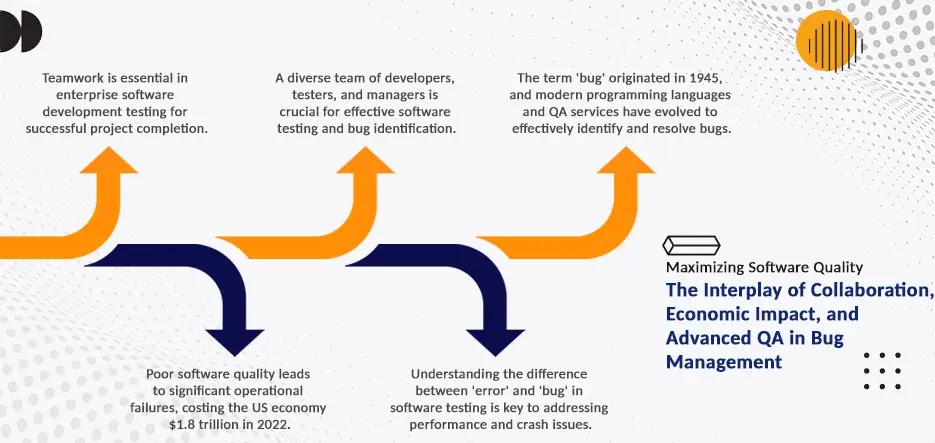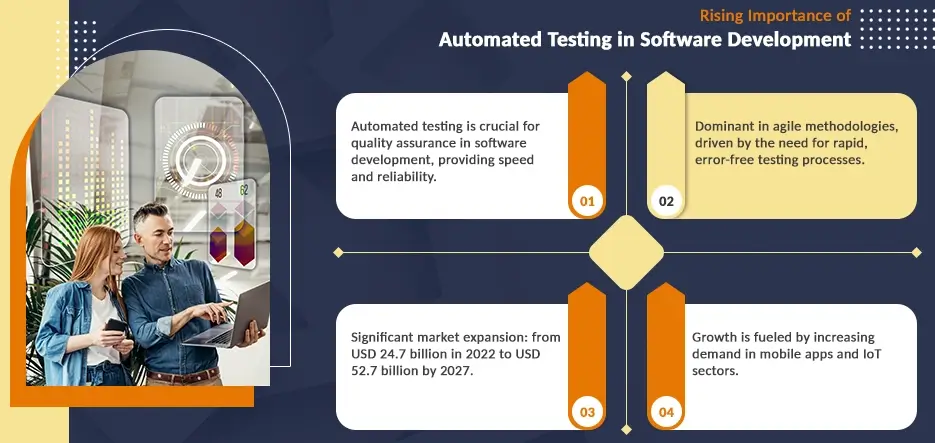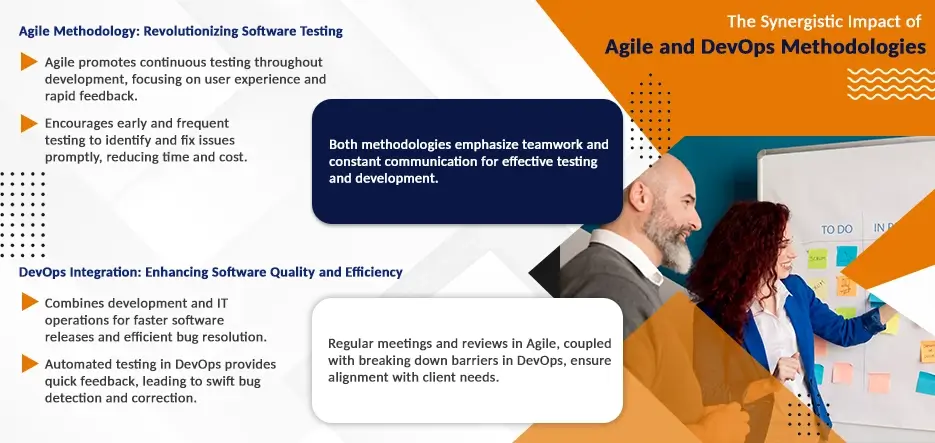Table of Contents
Often an intricate and meticulous Software Testing process is given to the enterprise software development testing team. Despite different competencies, a team with substantial collaboration makes the end product successful.
Software testers, developers, and project managers are the decision-makers who allocate roles & responsibilities and assurance for task completion in a given time frame. But, a potential vulnerability, such as a bug, can disturb the entire geography as well as the planning of the team. A Consortium for IT Software Quality (CISQ) study revealed that poor software quality resulted in operational software failures, costing the US economy an estimated $1.8 trillion in 2022.
Software testing process and QA services often involve people with distinct perspectives and abilities to test and identify different types of bugs. There has been various research on how collaboration must be maintained between software developers, managers, and testers.
Before understanding the types of bugs occurring in software, it is essential to understand the true definition of a bug.
In a testing process, identifying defects is often termed an “error.” The error is a mistake that results and is reflected in coding. A bug is thereby caused by the error found in the developmental ecosystem. An error or a bug can result in poor performance or crash of a program completely.
How was an error given the name of a bug?
History says that in 1945, during the testing of the Mark II, the machine suddenly stopped. The machine had a three inches moth, which was located and picked by the operator in between the relay contact. This moth was then affixed to the logbook, and there was the origin of the metaphor ‘bug.’
A bug is more difficult to deal with than an error. The best method to identify and resolve bugs is by outsourcing software testing and QA services. From the early days of testing, programming languages have revolutionized to prevent as many problems as possible.
To detect a bug faster and prioritize its fixing, software companies have started classifying bugs as per their nature and severity.

Types of Bugs and Errors Classified By Nature
1. Compatibility Error
Instability in the performance of specific hardware, software, operating system, and browser when integrating with different software or operating systems can result in a compatible defect. This division of bugs can be procured through compatibility testing. Network configuration is another aspect that can bring incompatibility errors. For instance, an upgrade in the Android version may change content alignment, scroll bar, & more.
2. Performance Error
As a part of product engineering, a performance testing methodology ensures substantial response time, speed, and consistency in the consumption of resources for adequate functionality and performance of software from top mobile app development companies in USA. When any error or delay occurs, it is counted as a performance defect. Performance error or defect also results in poor user experience and loss of business.
3. Operational Error
The intractable behavior of software with functional or operational requirements leads to this error. This again turns into a poor user experience, as when a user is looking for a product and the software or application does not respond with the desired result. This type of bug can easily be found through functional testing and can be overcome by resolving it ASAP.
4. Security Error
The potential weakness that can affect the entire system or software is the loophole on the security layer. Defects in the security layers are tested through rigorous security testing to highlight the susceptibility to SQL injections, buffer overflows, weak authentication, encryption errors, logical errors in role-based access, and XSS vulnerabilities.
5. Usability Error
The most futile defect is the inconvenience of using the app. A user would immediately abandon the software or application when it is not easy to use, has a difficult content layout, struggles to sign up with numerous fill-ins, and has a complex navigation system. Test engineers, through effective and different types of software testing process, can identify potential errors in software against usability requirements and validate them as per requirements.
We Uncover Errors Before They Cost You!
Expert Software Testing Services
6. Syntactic Error
Syntactic errors refer to grammatical or incorrect sentence formation. While testing a software’s GUI, an analyst may come across misspelled words that do deliver the meaning of action, taking extra time to relate and understand them. A syntactic error is different from a syntax error. A syntax error occurs when the code is not written in its true format and requires the developer to fix the problem.
7. Incorrect Calculations
This division of bugs does not come with a single cause. Wrong calculation numbers can provoke major accidents, leading to huge losses caused by data type mismatches, coding errors, incorrect algorithms, & more.
8. Communication Errors
A communication error is detected when the instructions and recommendations are not met as expected. For instance, the software may have an upgrade or a new feature added, but may not be able to find it. Not receiving a reminder or an alert of a new feature is a communication error.
9. Boundary Related Errors
For every text size, the number entered for the user is restricted to certain limits. Before deployment of the software testing process, a developer needs to anticipate these factors beforehand to ensure no error later.
10. Missing Command Errors
A missing command error denotes an event that cannot be closed without performing certain or needful actions. For instance, whether you wish to act or not, a popup may emerge and may not close due to the absence of a button or a logical option.
11. Error Handling Errors
Error handling is when a user adds invalid information. The information may also be misprinted or not mentioned. In such cases, if the user does not receive a quick reminder or alert of the misprints, then it is an error, which should be taken care of only to have valid data.
Categorizing Bugs by the Level of Severity
An engineer from a custom mobile app development company has to participate in various tasks while working with a dedicated software development team. This leads to confusion or failure to add a few requisites, leading to error or bug formation. Features such as product security and other errors can be detected and recovered through various testing methods. Also, with the help of these categories, the analyst can align the bugs as per the severity.
Here we have classified bugs in various levels to make it easy to prioritize as urgent or low-priority. Where urgent bugs require immediate attention and fixing within 24 hours, and low-priority do not require immediate attention, thereby giving developers a substantial amount of time to fix them.
1. Critical Errors
This criticality usually limits or blocks the complete module’s functionality or system. This kind of defect restrains the testing from moving further without fixing it.
2. High-Severity Errors
This type affects the functioning of the application. This way the application affects the user experience strongly, such as an email provider may not be allowed to add another recipient.
3. Medium Severity
This may be a minor fault in the software’s functionality, such as a broken link in a non-essential section.
4. Low-severity Errors
Errors, such as software design problems, such as UI color or pattern, maybe the least of the priority to fix, stating it in the low-severity section.
QA and software testing process are specially crafted with sensible and reliable resources and strategies to keep track of bugs and resolve them to promote general requirements for the software.
5. Management of the Vulnerability
Many organizations follow three phases to have a bug discovered and choose the right method to remediate it. With the assistance of a proper workflow and performance management, the software development process and testing team can be well assisted. The platform also allows peer-to-peer communication, manages, reviews, and inspects the schedules of project meetings, and more.
Seamless Testing, Superior Results!
Optimize your Software with Our Expert Services.
6. Strategic Decision Making
To have a successful bug fixing, the first step is to assign the right strategy and correct resources to align, as well as what consideration needs to be taken for security testing.
7. Vulnerability Discovery
After picking the right resources and strategies, the discovery phase identifies the loopholes. All teams are given different roles and responsibilities as well as timelines. The result decides which team is suitable for which category to retain the expected result.
8. Vulnerability Remediation
Here, the team decides on a way to fix the bug. Depending on the bug’s severity and timeframe, the team mitigates the potential risk. With the help of a systematic approach, QA software testing services can prove effective while consolidating with other teams for clear communications and success in the end.
Automated Testing Tools and Techniques
In software development, like at a custom software development company in USA, automation is key in the QA process in software testing. It means using special software to run tests and compare what happens with what should happen.
Now, the Software Testing Life Cycle is more automated. This is because we need quicker, more reliable tests. Before, manual testing took longer and had more errors. Automation is great for fast software development, like in agile methods. A report by MarketsandMarkets said the automated testing market is expected to grow from USD 24.7 billion in 2022 to USD 52.7 billion by 2027, at a CAGR of 16.4% during the forecast period. More mobile apps and IoT (Internet of Things) drive this. Automated testing checks if these work well and are safe.

Software testing allows you to find and fix major and minor defects, reducing risks and improving product quality. It also checks the user’s interaction with the software and presents situations when a user can make a mistake or misunderstand the program output. Moreover, testing helps to check the system’s resistance to malicious actions. – Nadya Bakhur
Why Automated Testing is Good
- Speed: Automation makes the software testing process in agile development quicker.
- Always the Same: Automated tests do the same thing every time and note everything.
- Find Bugs Early: Using automated testing early in development helps find problems sooner.
- Saves Money: Automated testing is costly at first but saves money later.
- Good for Complex Software: It’s great for testing complicated software.
Challenges of Automated Testing
- Setup: Starting automated testing takes time and money.
- Upkeep: You need to update automated tests often.
- Not for Everything: It’s not perfect for all types of testing.
- Need Skills: Teams need to learn how to use it.
- Tool Limits: Not all tools work for every software.
Automated testing tools are a big part of the software testing process, especially as software development moves fast and keeps changing. There are some challenges, but its benefits, like speed, accuracy, and cost-effectiveness, are important for modern QA in software testing. As technology grows, automated testing will get even better.
Role of AI and Machine Learning in Identifying Bugs
AI’s Impact on Bug Detection
Artificial Intelligence (AI) plays a crucial role in the ever-evolving field of software testing process, especially for QA software testers. AI’s inclusion in software testing has transformed bug detection and resolution. Before, finding bugs was manual and time-consuming, requiring much human effort. AI has changed this, making bug detection quicker, more precise, and efficient.
AI, especially machine learning-based algorithms, can process large data from the software testing process. This helps spot patterns and oddities that might show bugs. AI-driven testing tools can examine code, foresee likely bug locations, and hint at possible causes. This proactive bug detection saves time and lessens the risk of bugs reaching later, more complex development stages.
A major benefit of AI in bug detection is its ability to learn. As time passes, AI algorithms get better at spotting and predicting bugs, learning from past data to boost testing process efficiency. This is particularly useful in custom software development outsourcing, where each project has unique needs and challenges. AI’s flexibility ensures its effectiveness across different projects and environments.
Machine Learning in Software Testing
Machine learning is part of AI in software testing strategies. It has varied, significant roles in the software testing process. These algorithms can automate test case creation, predict the best testing strategies, and refine testing for greater coverage and effectiveness.
A prime use of machine learning in the software testing process is in regression testing. These tests are vital to ensure new code doesn’t harm existing functions. Machine learning models can use past test data and code changes to pinpoint at-risk application areas. This focused regression testing approach saves time and makes testing more thorough and effective.
Machine learning also excels in predictive analytics. Predictive models can foresee potential issues in software development, helping QA teams target their efforts. This foresight streamlines the software testing process, improves resource allocation, and quickens software market entry.
AI and machine learning’s role in bug detection in software testing is revolutionary. AI’s impact on bug detection and machine learning’s use in software testing enhances testing efficiency and effectiveness and shapes software development’s future. AI and machine learning’s integration in the software testing process will grow as technology progresses, offering advanced, intelligent solutions for QA software testers and developers.
Continuous Integration and Continuous Deployment (CI/CD) in Bug Detection
Continuous Integration (CI) and Continuous Deployment (CD) are key in modern software making. They are big in the custom software development companies in the USA. These methods make software delivery fast and smart.
In CI, you mix code changes often into one place. Each time you do this, an automated system checks the code. The goal? To catch problems early and make mixing easier.
The CD takes CI further. It automatically puts all code changes into a test or live area after they are built. This means teams can quickly give users new stuff and updates.
How CI/CD Helps Find and Fix Bugs
- Finding Bugs Early: CI/CD means you test code often. So, you find bugs as soon as they pop up. This is key in testing software because it stops too many bugs from piling up.
- Testing on Auto-Pilot: CI/CD uses a lot of automated testing in the software testing process. This is a big part of testing services. It tests every change right away. This fast check helps QA teams focus on harder tests.
- Consistency and Fewer Mistakes: CI/CD always follows the same steps for building, testing, and deploying code. This routine cuts down the mistakes that people might make.
- Better Software Quality: With CI/CD, software gets tested and sent out regularly. Developers work harder on making good code. They know it will get tested and used quickly.
- Working Together Better: CI/CD tools let teams see what’s happening in real-time. This is important for software testing services. It helps teams spot and fix problems fast. It also helps developers, testers, and operations work well together.
- Beta Testing Made Easy: CD helps with beta testing, an important step in testing software. It lets developers quickly show new things to beta testers, get feedback, and make changes.
- Using Different Tools: CI/CD can work with many tools and methods, like checking code quality, testing security, and watching performance. This mix makes sure the software is really good in many ways.
Impact of Agile and DevOps on Software Testing

Agile Methodology and Its Influence on Testing
Agile methodology has transformed how software is made and tested. It values flexibility, ongoing improvement, and customer happiness. This has greatly changed the way software testing companies work.
In Agile, testing starts at the project’s beginning and continues. It’s part of the whole development process. This means fast feedback and quick fixes. Agile testing cares about the user’s experience, not just if the code is right. This fits perfectly with custom software development consulting.
Agile encourages ‘test early and often.’ This finds and fixes problems early on. It cuts the cost and time to fix bugs. It also goes well with unit testing, ensuring each code part is right before moving on.
DevOps Practices in Identifying and Resolving Bugs
DevOps mixes software making (Dev) and IT operations (Ops). It improves the software testing process. DevOps means quicker software releases, better quality, and efficient bug finding and fixing for a software testing company.
These make sure new code is always tested and used right away. This cuts down manual work and human mistakes. Automated steps in DevOps give quick feedback on changes, leading to fast bug finding and fixing.
DevOps also focuses on monitoring and logging after release. This catches bugs missed during testing. Real-time tools and dashboards show how the app is doing. This helps teams fix problems before they impact users.
Collaboration and Communication
Agile and DevOps both highlight the importance of beta testing and team collaboration. Daily meetings and regular reviews keep everyone updated on progress and issues in Agile. DevOps breaks down walls between developers and operations, improving teamwork.
This teamwork is key for a custom software development agency in the USA. It ensures clear communication and understanding of client needs. The software meets technical and business goals.
Agile and DevOps have deeply changed the software testing process. They blend testing into development and promote working together and constant improvement. This lets software testing in custom development make better software faster. These methods are a big shift from old ways, matching today’s fast-changing tech needs.
In a Nutshell
Our look at software testing has shown us how crucial it is for QA and Software Testing. We’ve seen the various bugs in software development and how best to tackle them.
Knowing different bugs and errors is key to a good software testing process. This is especially true in custom software development. Understanding compatibility errors or security issues is vital to meet user expectations.
Technology changes, and so do bugs. Keeping up with new software development and testing trends, like in custom mobile app development services, is crucial for testers and companies.
Being proactive in the software testing process is essential. It means focusing on preventing problems, not just fixing them. This is especially important when outsourcing software testing services. Good communication and understanding of the project’s details are vital.
Some proactive steps include continuous testing from the start of development and using agile methods. Training QA teams in the latest trends and skills is also important to face new challenges in testing.
Software testing is a key part of making software. A deep understanding of bugs and a proactive approach ensure high-quality software. As technology and methods change, staying informed and adaptable is important for anyone in QA and Software Testing.
Using advanced software testing strategies is necessary for businesses. Outsourcing Testing Services can also be a good choice for specialized expertise and the latest technology.
Looking to improve your software testing process with A3Logics? Explore the newest in QA and software testing strategies. Talk to experts and start transforming your testing approach today.
Book 30 Minutes Free Consultations with A3Logics Experts to Start Your Software Journey Today!
FAQs
What’s the most common testing error?
The biggest mistake in software testing is often not checking everything. It means some parts aren’t tested fully, which might cause bugs. Testing all parts and situations is key to catching these hidden bugs.
How do big errors affect software making?
If missed early, big mistakes in making software can cause serious problems. They might lead to system crashes, data loss, security issues and harm the company’s image. Fixing these fast is crucial. They need quick action and resources, which might slow down other work and delay the project.
Why is it important to know different error types in testing?
Knowing different errors helps me plan and do tests better. Each error type needs its testing approach. For example, a usability error needs user testing, while a security error needs strict security checks. This knowledge helps testers find and fix errors the right way.
How can testing be better to find compatibility errors?
To better find compatibility errors:
- Test in Different Settings: Check the software on various systems, browsers, and devices.
- Use Automation: Use tools that automatically test in different settings.
- Test Continuously: Keep testing during development to find issues early.
Are there tools to automatically find syntax errors?
Yes, there are tools to automatically find syntax errors. These tools, part of coding environments or separate code-checking tools, scan the code to spot syntax mistakes quickly, reducing the chance of these errors reaching later development stages.






